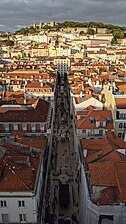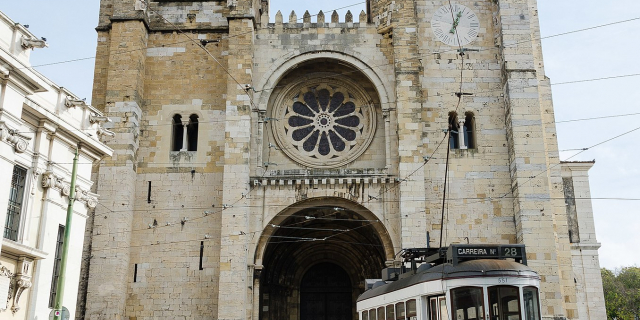Elevador de Santa Justa
( Santa Justa Lift )The Santa Justa Lift (Portuguese: Elevador de Santa Justa, pronounced [elɨvɐˈðoɾ ðɨ ˈsɐ̃tɐ ˈʒuʃtɐ]), also called Carmo Lift (Portuguese: Elevador do Carmo, [elɨvɐˈðoɾ ðu ˈkaɾmu]), is an elevator, or lift, in the civil parish of Santa Justa, in the historic center of Lisbon, Portugal. Situated at the end of Rua de Santa Justa, it connects the lower streets of the Baixa with the higher Largo do Carmo (Carmo Square).
Since its construction the lift has become a tourist attraction for Lisbon as, among the urban lifts in the city, Santa Justa is the only remaining vertical (conventional) one. Others, including Elevador da Glória and Elevador da Bica, are actually funicular railways, and the other lift constructed around the same time, the Elevator of São...Read more
The Santa Justa Lift (Portuguese: Elevador de Santa Justa, pronounced [elɨvɐˈðoɾ ðɨ ˈsɐ̃tɐ ˈʒuʃtɐ]), also called Carmo Lift (Portuguese: Elevador do Carmo, [elɨvɐˈðoɾ ðu ˈkaɾmu]), is an elevator, or lift, in the civil parish of Santa Justa, in the historic center of Lisbon, Portugal. Situated at the end of Rua de Santa Justa, it connects the lower streets of the Baixa with the higher Largo do Carmo (Carmo Square).
Since its construction the lift has become a tourist attraction for Lisbon as, among the urban lifts in the city, Santa Justa is the only remaining vertical (conventional) one. Others, including Elevador da Glória and Elevador da Bica, are actually funicular railways, and the other lift constructed around the same time, the Elevator of São Julião, has since been demolished.
The hills of Lisbon have always presented a problem for travel between the lower streets of the main Baixa and the higher Largo do Carmo (Carmo Square).[1] In order to facilitate the movement between the two, the civil and military engineer Roberto Arménio presented a project to the Lisbon municipal council in 1874.[2] A similar project was suggested in 1876, that included rail-lines that would be pulled by animals up an inclined plane.
In May 1882 founder and representative of the Companhia dos Ascensores Mecânicos de Lisboa, Raoul Mesnier du Ponsard,[2] petitioned the city council for permission to explore alternative plans for constructing an inclined transport moved by mechanical means. On 1 June 1882, Mesnier, a Porto-born engineer of French parentage, was granted a licence to proceed.
In 1896 Mesnier petitioned for the concession of this project, in order to establish the Escadinhas de Santa Justa, a request that was contested by Henry Lusseau. At the same time, the Serviços de Obras da Câmara (Municipal Public Services) supported Mesnier's petition, and the concession to authorize the construction and exploration of the Raoul Mesnier du Ponsard Elevator was approved.[3][2] It took two years to receive a provisional license to construct the structure. In 1899, the Empresa do Elevador do Carmo (Company of the Elevator of Carmo) was founded (constituted by principal partners Raoul Mesnier du Ponsard, medical surgeon João Silvestre de Almeida and the Marquess of Praia e Monforte, António Borges de Medeiros Dias da Câmara e Sousa) in order to secure the permanent concession of the elevator project for a period of 99 years.[2][4]
In 1900, the formal contract was signed between the Municipal Council of Lisbon and the Empresa do Elevador do Carmo (extinct in 1939), on which the working group was obligated to present a project for an elevator in a period of six months;[3] planning on the construction had already begun with the Lisbon branch of the metal constructors Cardoso D'Argent & Cia. (founded in 1897), on Rua Da Junqueira.[2] The founder, Manuel Cardoso, had already been placed in charge of the offices of firm Empresa Industrial Portuguesa and was responsible for the workers in the Elevador de Santa Justa project. By the middle of the year, the land that would be the main site was already in movement, establishing the footings and equipment house (2 June of the same year).[2][4]
On 31 August 1901, King Carlos inaugurated the metal bridge and awning,[4] in a ceremony that included members of the royal family, the members of the elevator company, Raoul Mesnier du Ponsard, and various members of the nobility and journalists.[2] Its initial operation was delayed: the operating car was only inaugurated in 1902[3] in the presence of the managing director of the concessionary company, Dr. Silvestre de Almeida, accompanied by journalists and other invited guests, in a ceremony presided over by the Secretary-General of the Civil Government.[2]
The operating concession was given to the company Lisbon Electric Tramway Ltd. in 1905.[2] Originally powered by steam, the lift was converted to electrical operation in 1907 by the British company R. Waygood,[3][4][5][6] and the respective concessionary company bought the Elevator in 1913, from the Empresa do Elevador do Carmo.[2]
RepublicIn 1943, the Lisbon Electric Tramway Ltd. solicited the city council to authorize the transfer of the elevator to the Companhia da Carris. The process was approved, with the condition that its operation should be integrated into the transport network, with the Companhia da Carris as the principal.[2]
By 1973, a contract was signed between the municipal council of Lisbon, the Companhia da Carris and the Lisbon Electric Tramway Ltd., transferring the Elevator definitively into the city's historical tram network.[2]
In July 2002, the Santa Justa Elevator celebrated its first centenary; along with the three remaining cable railways of Lavra, Glória and Bica, they were all classified as National Monuments in the same year.[1][2][4]
After remodelling and renovation, the elevator walkway was reopened in February 2006 for the general public and tourists.[2]







































Add new comment